336 books about Electronics and 14
start with N
336 books about Electronics and 14
336 books about Electronics
14 start with N start with N
14 start with N start with N

Nano-CMOS and Post-CMOS Electronics
Circuits and design, Volume 2
Saraju P. Mohanty
The Institution of Engineering and Technology, 2016
The demand for ever smaller and portable electronic devices has driven metal oxide semiconductor-based (CMOS) technology to its physical limit with the smallest possible feature sizes. This presents various size-related problems such as high power leakage, low-reliability, and thermal effects, and is a limit on further miniaturization. To enable even smaller electronics, various nanodevices including carbon nanotube transistors, graphene transistors, tunnel transistors and memristors (collectively called post-CMOS devices) are emerging that could replace the traditional and ubiquitous silicon transistor. This book explores these nanoelectronics at the circuit and systems levels including modelling and design approaches and issues.
[more]

Nano-CMOS and Post-CMOS Electronics
Devices and modelling, Volume 1
Saraju P. Mohanty
The Institution of Engineering and Technology, 2016
The demand for ever smaller and portable electronic devices has driven metal oxide semiconductor-based (CMOS) technology to its physical limit with the smallest possible feature sizes. This presents various size-related problems such as high power leakage, low-reliability, and thermal effects, and is a limit on further miniaturization. To enable even smaller electronics, various nanodevices including carbon nanotube transistors, graphene transistors, tunnel transistors and memristors (collectively called post-CMOS devices) are emerging that could replace the traditional and ubiquitous silicon transistor. This book explores these nanoelectronics at the device level including modelling and design.
[more]
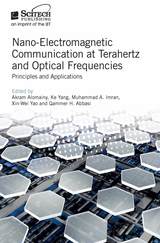
Nano-Electromagnetic Communication at Terahertz and Optical Frequencies
Principles and Applications
Akram Alomainy
The Institution of Engineering and Technology, 2020
Recent advancements in carbon and molecular electronics have opened the door to a new generation of electronic nanoscale components. This book outlines the basic principles of electromagnetic-based communication at this nanoscale using terahertz and optical frequencies with a focus on theoretical principles and applications. It answers the questions: How can nano-devices communicate with each other by applying electromagnetic techniques? Do conventional communication and networking schemes and principles still apply? How feasible is it to deploy such networks with various applications?
[more]
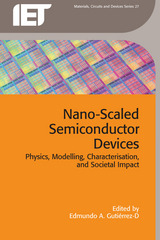
Nano-Scaled Semiconductor Devices
Physics, modelling, characterisation, and societal impact
Edmundo A. Gutiérrez-D
The Institution of Engineering and Technology, 2016
The rapid evolution of integrated circuit technology has brought with it many new materials and processing steps at the nano-scale which boost the electrical performance of devices, resulting in faster and more functionally-complex electronics. However, working at this reduced scale can bring second order effects that degrade efficiency and reliability.
[more]
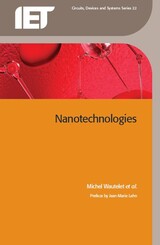
Nanotechnologies
Michel Wautelet
The Institution of Engineering and Technology, 2009
How can single atoms be manipulated? Are the laws of physics still valid at the nanostructure scale? How could nanotechnologies help cure disease? What are the application fields of nanotechnologies and what ethical issues do they raise? These questions and many others are answered in this clearly presented, fascinating book.
[more]
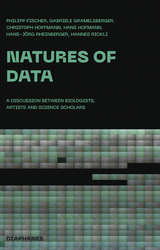
Natures of Data
A Discussion between Biologists, Artists and Science Scholars
Philipp Fischer, Gabriele Gramelsberger, Christoph Hoffmann, Hans Hofmann, Hans-Jörg Rheinberger, and Hannes Rickli
Diaphanes, 2020
Computer-based technologies for the production and analysis of data have been an integral part of biological research since the 1990s at the latest. This not only applies to genomics and its offshoots but also to less conspicuous subsections such as ecology. But little consideration has been given to how this new technology has changed research practically. How and when do data become questionable? To what extent does necessary infrastructure influence the research process? What status is given to software and algorithms in the production and analysis of data? These questions are discussed by the biologists Philipp Fischer and Hans Hofmann, the philosopher Gabriele Gramelsberger, the historian of science and biology Hans-Jörg Rheinberger, the science theorist Christoph Hoffmann, and the artist Hannes Rickli. The conditions of experimentation in the digital sphere are examined in four chapters—“Data,” “Software,” “Infrastructure,” and “in silico”—in which the different perspectives of the discussion partners complement one another. Rather than confirming any particular point of view, Natures of Data deepens understanding of the contemporary basis of biological research.
[more]
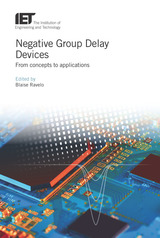
Negative Group Delay Devices
From concepts to applications
Blaise Ravelo
The Institution of Engineering and Technology, 2019
Negative Group Delay Devices: From concepts to applications introduces the theoretical concept, analysis, design methodology and implementation of negative group delay (NGD). The NGD concept is a recent topic in electrical and electronic engineering research based on an unconventional function; the generation of an output signal seemingly in time-advance of the input signal. The NGD function has been exploited to develop experimental high-performance electronic devices, and novel design features of radio frequency (RF) and microwave electronic devices, such as filters, power dividers and amplifiers. Examples include the realization of non-Foster reactive elements, shortening or reducing delay lines, enhancing the efficiency of feedforward linear amplifiers, improvement of phase shifters accuracy and bandwidth, equalization of electrical interconnect effects for the microwave, digital and mixed signal integrity improvement, and minimizing beam-squint in series-fed antenna arrays.
[more]

Neural Network Applications in Control
G.W. Irwin
The Institution of Engineering and Technology, 1995
Neural networks are an exciting technology of growing importance in real industrial situations, particularly in control and systems. This book aims to give a detailed appreciation of the use of neural nets in these applications; it is aimed particularly at those with a control or systems background who wish to gain an insight into the technology in the context of real applications.
[more]
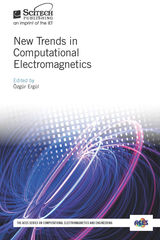
New Trends in Computational Electromagnetics
Özgür Ergül
The Institution of Engineering and Technology, 2020
Computational electromagnetics is an active research area concerned with the development and implementation of numerical methods and techniques for rigorous solutions to physical problems across the entire spectrum of electromagnetic waves - from radio frequencies to gamma rays. Numerical methods and techniques developed and implemented in this area are now used every day to solve complex problems in diverse application areas, including but not limited to antennas, telecommunications, biomedical imaging, sensing, energy harvesting, nanotechnology, and optics. The purpose of this book is to provide a broad overview of the recent efforts in computational electromagnetics to develop and implement more robust, stable, accurate, and efficient algorithms.
[more]
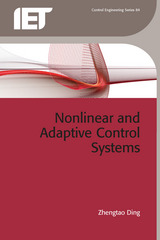
Nonlinear and Adaptive Control Systems
Zhengtao Ding
The Institution of Engineering and Technology, 2013
An adaptive system for linear systems with unknown parameters is a nonlinear system. The analysis of such adaptive systems requires similar techniques to analyse nonlinear systems. Therefore it is natural to treat adaptive control as a part of nonlinear control systems. Nonlinear and Adaptive Control Systems treats nonlinear control and adaptive controlin a unified framework, presenting the major results at a moderate mathematical level, suitable for MSc students and engineers with undergraduate degrees. Topics covered include introduction to nonlinear systems; state space models; describing functions forcommon nonlinear components; stability theory; feedback linearization; adaptive control; nonlinear observer design; backstepping design; disturbance rejection and output regulation; and control applications, including harmonic estimation and rejection inpower distribution systems, observer and control design for circadian rhythms, and discrete-time implementation of continuous-timenonlinear control laws.
[more]
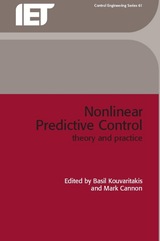
Non-linear Predictive Control
Theory and practice
Basil Kouvaritakis
The Institution of Engineering and Technology, 2001
Model-based predictive control (MPC) has proved to be a fertile area of research. It has gained enormous success within industry, especially in the context of process control. Nonlinear model-based predictive control (NMPC) is of particular interest as this best represents the dynamics of most real plant. This book collects together the important results which have emerged in this field, illustrating examples by means of simulations on industrial models. In particular there are contributions on feedback linearisation, differential flatness, control Lyapunov functions, output feedback, and neural networks. The international contributors to the book are all respected leaders within the field, which makes for essential reading for advanced students, researchers and industrialists in the field of control of complex systems.
[more]
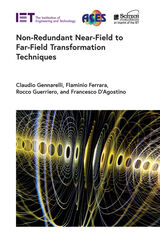
Non-Redundant Near-Field to Far-Field Transformation Techniques
Claudio Gennarelli
The Institution of Engineering and Technology, 2022
Near-field (NF) measurement techniques and the related NF to far-field (FF) transformations are gaining interest for their ability to allow an accurate evaluation of the radiation characteristics of those antennas whose electric sizes do not make it possible to perform direct FF measurements in a controlled and reflection-free environment, such as the anechoic chamber.
[more]
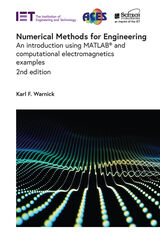
Numerical Methods for Engineering
An introduction using MATLAB® and computational electromagnetics examples
Karl F. Warnick
The Institution of Engineering and Technology, 2020
The revised and updated second edition of this textbook teaches students to create modeling codes used to analyze, design, and optimize structures and systems used in wireless communications, microwave circuits, and other applications of electromagnetic fields and waves. Worked code examples are provided for key algorithms using the MATLAB technical computing language.
[more]

Numerical Methods for Engineering
An introduction using MATLAB® and computational electromagnetics examples
Karl F. Warnick
The Institution of Engineering and Technology, 2011
This textbook teaches students to create computer codes used to engineer antennas, microwave circuits, and other critical technologies for wireless communications and other applications of electromagnetic fields and waves. Worked code examples are provided for MATLAB technical computing software. It is the only textbook on numerical methods that begins at the undergraduate engineering student level but brings students to the state-of-the-art by the end of the book. It focuses on the most important and popular numerical methods, going into depth with examples and problem sets of escalating complexity. This book requires only one core course of electromagnetics, allowing it to be useful both at the senior and beginning graduate levels. Developing and using numerical methods in a powerful tool for students to learn the principles of intermediate and advanced electromagnetics. This book fills the missing space of current textbooks that either lack depth on key topics (particularly integral equations and the method of moments) and where the treatment is not accessible to students without an advanced theory course. Important topics include: Method of Moments; Finite Difference Time Domain Method; Finite Element Method; Finite Element Method-Boundary Element Method; Numerical Optimization; and Inverse Scattering.
[more]
READERS
Browse our collection.
PUBLISHERS
See BiblioVault's publisher services.
STUDENT SERVICES
Files for college accessibility offices.
UChicago Accessibility Resources
home | accessibility | search | about | contact us
BiblioVault ® 2001 - 2024
The University of Chicago Press









